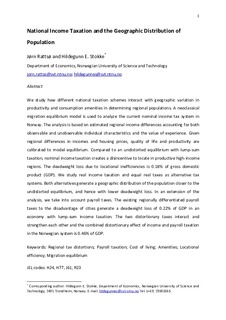| dc.contributor.author | Rattsø, Jørn | |
| dc.contributor.author | Stokke, Hildegunn Ekroll | |
| dc.date.accessioned | 2017-12-04T08:28:17Z | |
| dc.date.available | 2017-12-04T08:28:17Z | |
| dc.date.created | 2016-12-22T14:15:09Z | |
| dc.date.issued | 2016 | |
| dc.identifier.citation | International Tax and Public Finance. 2016, 24 (5), 879-902. | nb_NO |
| dc.identifier.issn | 0927-5940 | |
| dc.identifier.uri | http://hdl.handle.net/11250/2468867 | |
| dc.description.abstract | We study how different national taxation schemes interact with geographic variation in productivity and consumption amenities in determining regional populations. A neoclassical migration equilibrium model is used to analyze the current nominal income tax system in Norway. The analysis is based on estimated regional income differences accounting for both observable and unobservable individual characteristics and the value of experience. Given regional differences in incomes and housing prices, quality of life and productivity are calibrated to model equilibrium. Compared to an undistorted equilibrium with lump-sum taxation, nominal income taxation creates a disincentive to locate in productive high-income regions. The deadweight loss due to locational inefficiencies is 0.18% of gross domestic product (GDP). We study real income taxation and equal real taxes as alternative tax systems. Both alternatives generate a geographic distribution of the population closer to the undistorted equilibrium, and hence with lower deadweight loss. In an extension of the analysis, we take into account payroll taxes. The existing regionally differentiated payroll taxes to the disadvantage of cities generate a deadweight loss of 0.22% of GDP in an economy with lump-sum income taxation. The two distortionary taxes interact and strengthen each other and the combined distortionary effect of income and payroll taxation in the Norwegian system is 0.46% of GDP. | nb_NO |
| dc.language.iso | eng | nb_NO |
| dc.publisher | Springer Verlag | nb_NO |
| dc.title | National income taxation and the geographic distribution of population | nb_NO |
| dc.type | Journal article | nb_NO |
| dc.type | Peer reviewed | nb_NO |
| dc.description.version | acceptedVersion | nb_NO |
| dc.source.pagenumber | 879-902 | nb_NO |
| dc.source.volume | 24 | nb_NO |
| dc.source.journal | International Tax and Public Finance | nb_NO |
| dc.source.issue | 5 | nb_NO |
| dc.identifier.doi | 10.1007/s10797-016-9430-3 | |
| dc.identifier.cristin | 1416884 | |
| dc.description.localcode | © Springer Verlag. This is the authors' accepted and refereed manuscript to the article. The final publication is available at https://link.springer.com/article/10.1007%2Fs10797-016-9430-3 | nb_NO |
| cristin.unitcode | 194,60,20,0 | |
| cristin.unitname | Institutt for samfunnsøkonomi | |
| cristin.ispublished | true | |
| cristin.fulltext | postprint | |
| cristin.qualitycode | 1 | |
